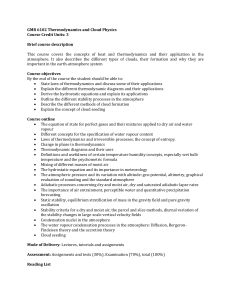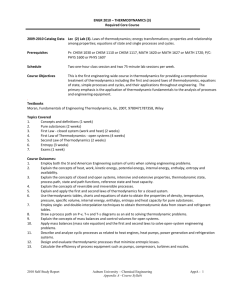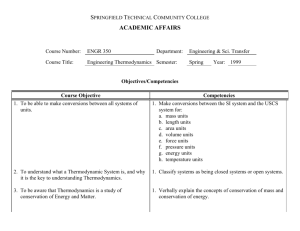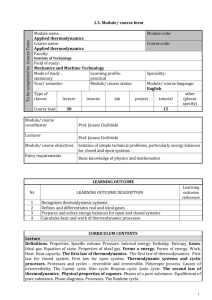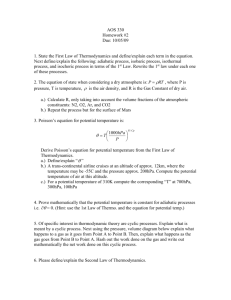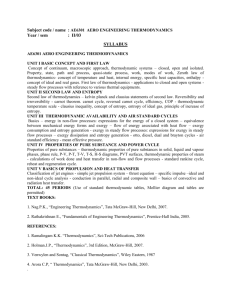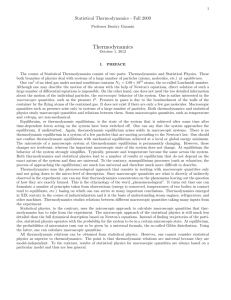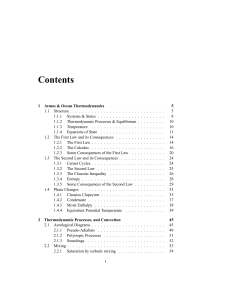EAS3603OutlineF2010web
advertisement
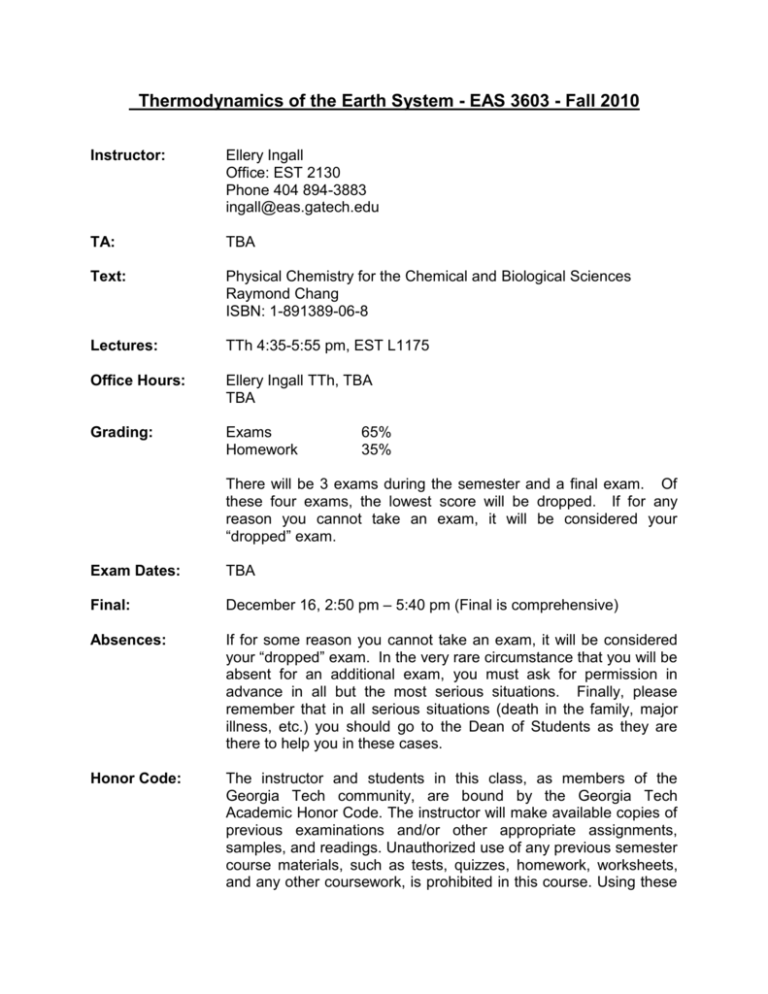
Thermodynamics of the Earth System - EAS 3603 - Fall 2010 Instructor: Ellery Ingall Office: EST 2130 Phone 404 894-3883 ingall@eas.gatech.edu TA: TBA Text: Physical Chemistry for the Chemical and Biological Sciences Raymond Chang ISBN: 1-891389-06-8 Lectures: TTh 4:35-5:55 pm, EST L1175 Office Hours: Ellery Ingall TTh, TBA TBA Grading: Exams Homework 65% 35% There will be 3 exams during the semester and a final exam. Of these four exams, the lowest score will be dropped. If for any reason you cannot take an exam, it will be considered your “dropped” exam. Exam Dates: TBA Final: December 16, 2:50 pm – 5:40 pm (Final is comprehensive) Absences: If for some reason you cannot take an exam, it will be considered your “dropped” exam. In the very rare circumstance that you will be absent for an additional exam, you must ask for permission in advance in all but the most serious situations. Finally, please remember that in all serious situations (death in the family, major illness, etc.) you should go to the Dean of Students as they are there to help you in these cases. Honor Code: The instructor and students in this class, as members of the Georgia Tech community, are bound by the Georgia Tech Academic Honor Code. The instructor will make available copies of previous examinations and/or other appropriate assignments, samples, and readings. Unauthorized use of any previous semester course materials, such as tests, quizzes, homework, worksheets, and any other coursework, is prohibited in this course. Using these materials will be considered a direct violation of academic policy and will be dealt with according to the GT Academic Honor Code. The complete text of the Academic Honor Code may be found at http://www.honor.gatech.edu/plugins/content/index.php?id=9 Web Page: Class materials will be posted on t-square Course Topics: PART 1: INTRODUCTION Introduction What is thermodynamics? Why study thermodynamics of the Earth system? Thermodynamic systems: composition and state; system vs the environment; open or closed or isolated; boundaries of a system and the environment, Thermodynamic state of a system: state variables (intensive and extensive); thermodynamic properties; equation of state State variables: pressure, temperature, volume/density; units Composition and structure of components of the earth system Composition: atmosphere, ocean, solid earth Pressure: units; vertical variations in the atmosphere, ocean, solid earth; space/time variability Density (specific volume): units; vertical variations in the atmosphere, ocean, solid earth Temperature: units; vertical variations in the atmosphere, ocean, and solid earth; space/time variability Hydrostatic equation: application to ocean and hypothetical constant density atmosphere; solid earth Equation of state Ideal gas law Kinetic-molecular model of the ideal gas Equation of state for air: Dalton’s law of partial pressures; virtual temperature Hypsometric equation (atmosphere) Equation of state for real gases, liquids, and solids Equation of state for seawater PART 2: FRAMEWORK First Law of thermodynamics Basic concepts Mathematical review: differentials and derivatives, exact differentials Work; expansion work Heat: heat capacity, basics of heat transfer mechanisms First law of thermodynamics: internal energy, enthalpy, specific heats, heat capacity. Applications of first law to ideal gases: Poisson’s relations Entropy and the 2nd law Entropy: reversible and irreversible processes; Clausius inequality; BoltzmannGibbs statistical picture of entropy 2nd Law of thermodynamics First and second laws combined: Legendre transformations: Gibbs and Helmholtz functions; thermodynamic equilibrium Thermodynamic relations: Maxwell relations; relations involving specific heats Adiabatic processes in the dry atmosphere, ocean, and mantle and core Static stability Entropy and diffusive processes (heat conduction, viscosity, etc) Entropy, heat, and the 3rd law Phase Equilibria Gibbs phase rule: thermodynamic degrees of freedom, phases and components Energy in phase changes and chemical reactions Phase equilibria: chemical potential and multicomponent systems (GibbsDuhem); latent heat; Clapeyron equation (first latent heat law) Application to water (single component system): phase diagram; ClausiusClapeyron equation; Binary phase diagrams (water solution): simple eutectics, lever rule Crystallization in binary systems: equilibrium crystallization, fractional crystallization, melting PART 3: APPLICATIONS Moist thermodynamic processes in the atmosphere Humidity variables Isobaric cooling: dew point and frost point; radiation fog Cooling and moistening by evaporation of water: wetbulb temperature; prefrontal rain fog Saturation by adiabatic, isobaric mixing: steam fog and jet contrails Saturated adiabatic cooling: equivalent potential temperature; saturated adiabatic lapse rate, adiabatic liquid water content; convective cloud formation Aerological diagrams Physical chemistry of water solutions – solution thermodynamics Fugacity and activity Ideal solutions (Real solutions: variation of activities) Aquatic chemistry
